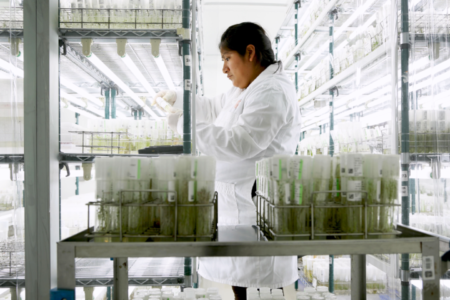Among the many challenges posed by climate change and its impacts on agriculture, improving plant health faces numerous obstacles and yet holds perhaps the greatest potential for strengthening food systems and supporting small farmers in the world’s poorest countries.
As the world pivots to address the many questions posed by climate change, researchers are focused on improving agriculture to anticipate and adapt to future challenges. Robust food systems begin with healthy plants, and healthy plants are key to insuring support and livelihoods for small farmers in the world’s poorest countries. For this reason, the UN declared 2020 the International Year of Plant Health.
The head of the GHU at the International Potato Center (CIP), Jan Kreuze, welcomed the guests with an introductory video that provided an overview of the CGIAR’s work with germplasm, which tests more than 450,000 germplasm samples a year to ensure their cleanliness for proper reproduction and healthy crops. Equally important, said Kreuze, “is the preservation of germplasm for safeguarding biodiversity for future generations.”

Most problems with germplasm transfer occur when it is exchanged between two countries that do not follow similar protocol for handling and sharing. “Thus, integrated measures for international transfers of source plants need stronger and more consistent enforcement by national and international bodies related to agriculture,” according to Mirko Montuori, a Deputy Team Leader and Project Officer with the International Plant Protection Convention, an organization that provides such standards.
While germplasm, on its face, appears to be a topic of hard science, Vivian Polar, a gender senior specialist at CIP, reminded the gathering, the fact that genetic materials “move through” humans means the social context must also be evaluated, especially in regard to men and women and their roles in agriculture. If we are to create an improved environment for safe germplasm exchange, men and women need to be involved equally. Polar also noted 40% of GHU staff in the CGIAR are women – a good first step towards strengthen women’s leadership in plant health issues.
- CIP’s genebank is the world’s largest repository of germplasm for potato, sweetpotato, and Andean roots and tubers. This collection ensures that crop plants which may contain genes to resist disease, provide enhanced nutrition, or survive in changing or harsh environments.
- Since its inception, the CIP genebank has distributed more than 107,000 germplasm samples to 164 countries to help small holder farmers grow more food and to improve nutrition for families around the world. Of those countries, China has received the most samples (6,421) and Colombia is second (5,867).
The third of the four webinars on plant health is scheduled for March 10 and will focus on integrated pest and disease management.
A video replay of webinar 2 is available here.
